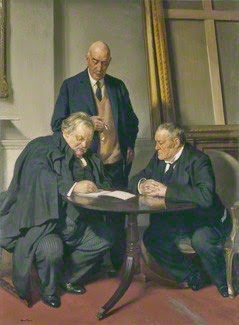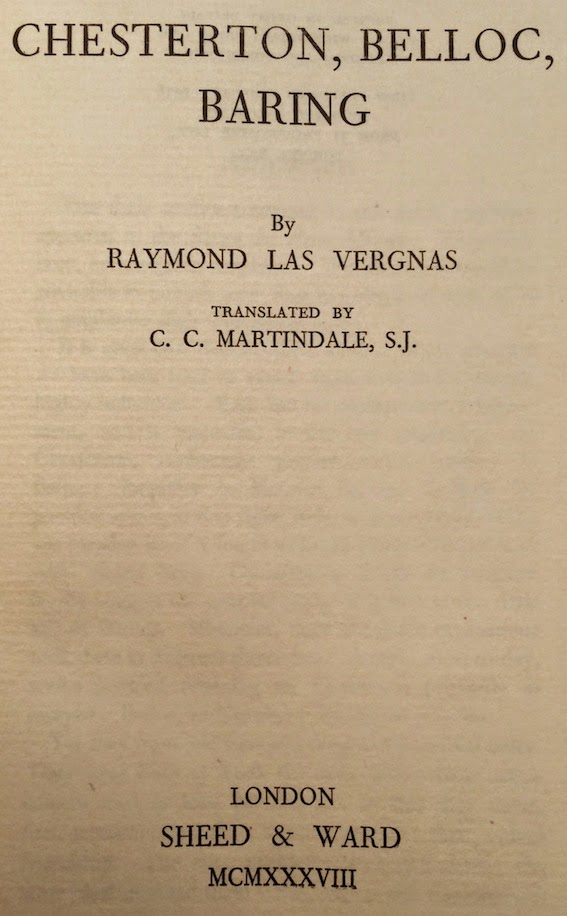
Found in the vast Jimmy Kanga collection a work on three of his favourite writers. Nearly 10% of his 20,000 books are by or are related to this British Catholic triumvirate, many in multiples... The book is Chesterton, Belloc, Baring by Raymond Las Vergnas (Sheed & Ward, London 1938.) The jacket shows Sir (Herbert) James Gunn's oil painting Conversation Piece (G.K. Chesterton; Maurice Baring; Hilaire Belloc). The picture resides at the National Portrait Gallery with this note in the catalogue:'The idea for the portrait came to Gunn at a dinner to celebrate Belloc's 60th birthday ; the completed work was shown at the Royal Academy in 1932.'
From the foreword to the book :
 |
| Inside d/w blurb |
It is quite true that the three authors whose portraits we have here tried to sketch were, first and foremost, highly individual. Each had his characteristic temperament, and a vigourous, undisguised originality. In Chesterton, exuberance predominates: lucidity in Belloc: limpidity in Maurice Baring. A taste for paradox seems, at first sight, to be common to all three: yet paradox itself is found to be, in them, susceptible of very varied hues. Chesterton's shouts of laughter hardly suggest the guarded irony of Belloc or the Attic salt of Baring. Moreover, their dominant inclinations took them in different directions. A critic, even-to-day, seems justified fastening on Chesterton primarily as essayist; Belloc, as historian; Baring, as novelist.
 Yet they meet and fuse in a deep and powerful unity. They were born at much the same time; their active careers were at least parallel, and to this they owed, first, acquaintance; then, a mutual esteem; then, a close friendship. The same problems fascinated them: the same ideal directed them: they met in the Communion of a self-same Faith. The Catholic Faith did indeed provide one and the self-same inspiration not only to their work, but to their very being. Against the general background of after-war English letters, one sees them standing out ever more clearly as a trinity. Yes; they are 'the Three Catholics,' indeed, the 'Three Great Papists,' as not a few have already liked to nick-name them.
Yet they meet and fuse in a deep and powerful unity. They were born at much the same time; their active careers were at least parallel, and to this they owed, first, acquaintance; then, a mutual esteem; then, a close friendship. The same problems fascinated them: the same ideal directed them: they met in the Communion of a self-same Faith. The Catholic Faith did indeed provide one and the self-same inspiration not only to their work, but to their very being. Against the general background of after-war English letters, one sees them standing out ever more clearly as a trinity. Yes; they are 'the Three Catholics,' indeed, the 'Three Great Papists,' as not a few have already liked to nick-name them.
Further still;, we find united together in their love for France,a love that they have always sought to express with so much culture and alertness, and so effectively. All three sought with an equal ardour to present France under her true aspects to English eyes. One of these three 'Friends of France,' Chesterton, has died. On the morrow of so grave a loss to Anglo-French literature, it seems to us not only right, but a duty, to associate with his great memory the greatness of those other two who toil at the self-same task.
We can pray for no worthier justification of this book.
Rayond Las Vergnas December, 1936
